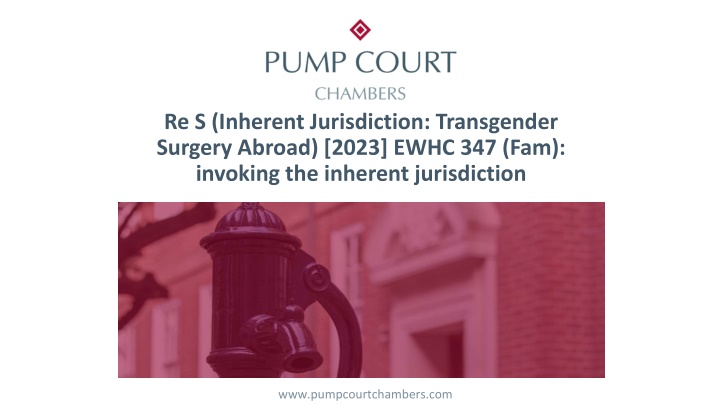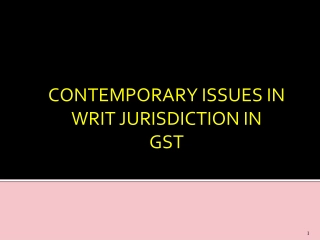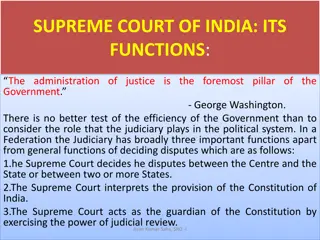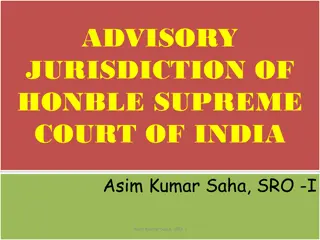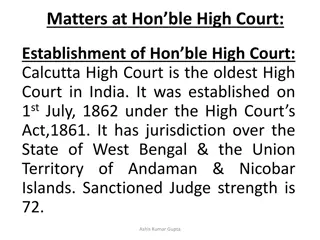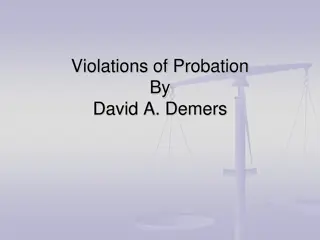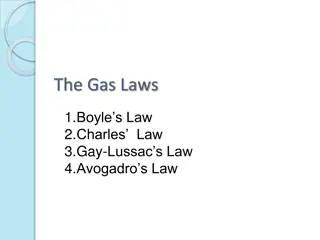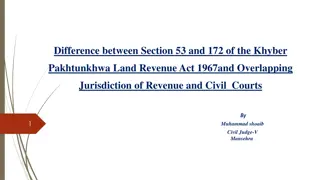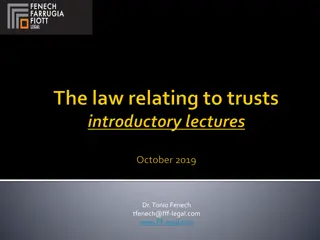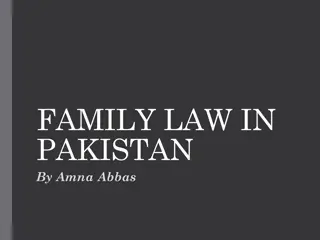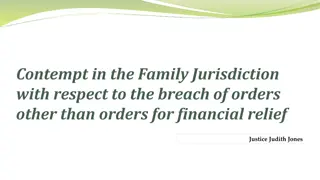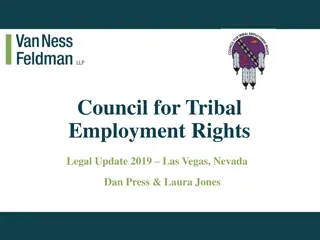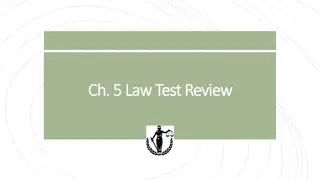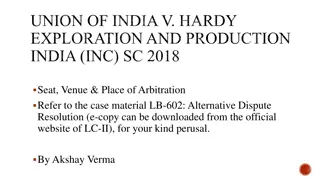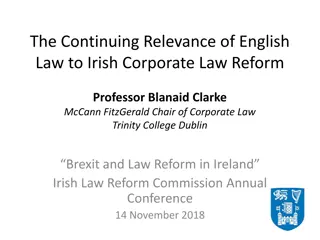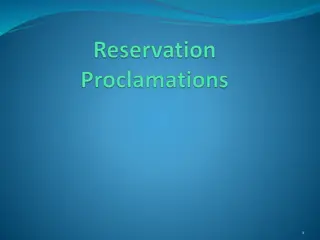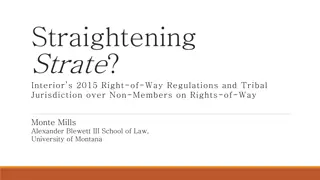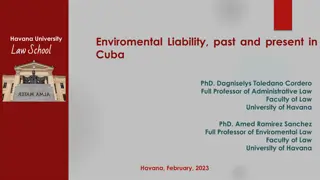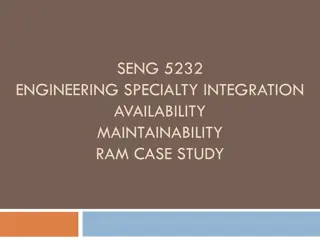Evolution of Wardship and Inherent Jurisdiction in English Law
The concept of wardship, originating in the Middle Ages, evolved over time to prioritize the welfare of children under the Court's care. Wardship transitioned from feudal control to protection against parental abuse, with broad powers granted to the High Court. Changes in legislation, such as the Family Law Reform Act 1969 and the Children Act 1989, reformed the pathways for child protection, moving away from traditional wardship proceedings.
Download Presentation

Please find below an Image/Link to download the presentation.
The content on the website is provided AS IS for your information and personal use only. It may not be sold, licensed, or shared on other websites without obtaining consent from the author.If you encounter any issues during the download, it is possible that the publisher has removed the file from their server.
You are allowed to download the files provided on this website for personal or commercial use, subject to the condition that they are used lawfully. All files are the property of their respective owners.
The content on the website is provided AS IS for your information and personal use only. It may not be sold, licensed, or shared on other websites without obtaining consent from the author.
E N D
Presentation Transcript
Re S (Inherent Jurisdiction: Transgender Surgery Abroad) [2023] EWHC 347 (Fam): invoking the inherent jurisdiction www.pumpcourtchambers.com
Definitions and a potted history Inherent means existing in someone or something as a natural and inseparable quality, characteristic or right Wardship means that a child who is made a ward of the Court is under its care and control Wardship was introduced in the Middle Ages by William the Conqueror. It was part of a hierarchal structure which allowed a feudal lord to assume control of the affairs of an orphaned tenant until they were of age.
Wardship and the inherent jurisdiction Once feudalism was abolished, it became the province of the Chancery Division Through the 19thcentury the emphasis of wardship began to be on the welfare of the child and was extended to protect children affected by marriage breakdown, although it was still infrequently used, and mostly where there were large assets involved Think Bleak House , and those poor wards of Jarndyce v Jarndyce: The one great principle of the English law is, to make business for itself. There is no other principle distinctly, certainly, and consistently maintained through all its narrow turnings. Viewed by this light it becomes a coherent scheme, and not the monstrous maze the laity are apt to think it. Let them but once clearly perceive that its grand principle is to make business for itself at their expense, and surely they will cease to grumble.
Wardship (history) What power was the Court exercising in wardship? Lord Denning MR in In re L (An Infant) [1968] 119, said: It derives from the right and duty of the Crown as parens patriae to take care of those who are not able to take care of themselves. The Crown delegated this power to the Lord Chancellor, who exercised it in his Court of Chancery. the Court of Chancery had power to interfere for the protection of the infant by making whatever order might be appropriate. In time, that power became vested in the High Court and exercisable by any judge of the High Court who could make orders using its inherent jurisdiction
Wardship (cont) In 20thcentury, Wardship was on the rise as Local Authorities began to use it to protect children from parental abuse. The Family Law Reform Act 1969 gave the High Court the power to place a ward of court under the care or supervision of a Local Authority. Wardship was a popular route for local authorities to follow because it provided very broad and flexible grounds for proceedings to commence However, change was coming. Before the Children Act 1989 was enacted, there were various different routes by which children might come to be removed from their families. Those routes included wardship proceedings, matrimonial proceedings and magistrates court proceedings all of which made orders on different grounds, and with different legal consequences
Wardship (cont) if children had been committed to its care by a Court (or they had assumed parental rights) the local authority was in complete control of where the child was placed and of the contact that the child could have with parents and other family members. But, in uncomfortable contradiction, the notion of wardship was that the child was under the care and control of the Court, so any significant decision or step in the child s life required the Court s approval
Introduction of Children Act 1989 The Children Act 1989 modified and codified huge swathes of the law relating to children It was intended to get rid of the disparities and discrepancies between the routes to state care and ensure greater fairness, unity and an appropriate division of responsibilities between court and state Introduced Part IV proceedings for Care and Supervision Orders, the s31 threshold provisions and the s1(3) Welfare Checklist making the child s welfare the court s paramount consideration
Introduction of the CA 1989 (cont) As a result the High Court lost the power under its inherent jurisdiction to place children in the care and control of a local authority, and to make children who are subject to care orders wards of court. A local authority s ability to make an application is now severely circumscribed by section 100 CA 1989.
S100 Children Act 1989 (2)No court shall exercise the High Court s inherent jurisdiction with respect to children (a)so as to require a child to be placed in the care, or put under the supervision, of a local authority; (b)so as to require a child to be accommodated by or on behalf of a local authority; (c)so as to make a child who is the subject of a care order a ward of court; or (d)for the purpose of conferring on any local authority power to determine any question which has arisen, or which may arise, in connection with any aspect of parental responsibility for a child. What does that mean?
S100 CA 1989 (cont) (3)No application for any exercise of the court s inherent jurisdiction with respect to children may be made by a local authority unless the authority have obtained the leave of the court. (4)The court may only grant leave if it is satisfied that (a)the result which the authority wish to achieve could not be achieved through the making of any order of a kind to which subsection (5) applies; and (b)there is reasonable cause to believe that if the court s inherent jurisdiction is not exercised with respect to the child he is likely to suffer significant harm
S100 CA 1989 (cont) and FPR 1991 PD 12D (5)This subsection applies to any order (a)made otherwise than in the exercise of the court s inherent jurisdiction; and (b)which the local authority is entitled to apply for (assuming, in the case of any application which may only be made with leave, that leave is granted). The Act is further bolstered by Practice Direction 12D FPR 1991: wardship proceedings should not be commenced unless the issues cannot be resolved under the Act
Use of inherent jurisdiction since CA 1989 So what is the inherent jurisdiction used for now? According to Black LJ in Re T [2021] UKSC 35 it still has an essential function: 67. The inherent jurisdiction has had to rise to the challenge of some of the most extreme human and moral dilemmas imaginable . As Lord Donaldson of Lymington MR said in In re F (Mental Patient: Sterilisation) [1990] 2 AC 1, p 13 (in a passage approved by the House of Lords on appeal): the common law is the great safety net which lies behind all statute law and is capable of filling gaps left by that law, if and in so far as those gaps have to be filled in the interests of society as a whole. This process of using the common law to fill gaps is one of the most important duties of the judges.
Use of inherent jurisdiction since CA 1989 (cont) And at paragraph 119 the more general conditions imposed by [s100] subsections (3) to (5) are shaped to confine the local authority to orders otherwise available to them, but building in a safety net where those other orders would not achieve the required result in a risky situation DOLS cases particularly where s25 accommodation is not available but a secure placement is required: Black LJ in Re T at paragraph 141: it is unthinkable that the High Court, with its long established role in protecting children, should have no means to keep these unfortunate children safe from extreme harm, in some cases death
Use of inherent jurisdiction since CA 1989 (cont) Cross-border disputes concerning children (in circumstances where there is no other available jurisdiction and the circumstances of the case require its exercise or make it necessary : Re M [2020] EWCA Civ 922) Decisions about treating/withholding life prolonging treatment of children for example separation of conjoined twins [2001], Charlie Gard [2017]: Francis J A child s parents having parental responsibility have the power to give consent for their child to undergo treatment, but overriding control is vested in the court exercising its independent and objective judgment in the child s best interests
Re S (Inherent Jurisdiction: Transgender Surgery Abroad) [2023] EWHC 347 (Fam) Judgment of Sir Andrew McFarlane P handed down on 1 February 2023 S was 15; assigned to female gender at birth but living socially as a boy for some years Did not regard himself as trans-sexual; referred to in proceedings as he/him S and his parents were born and are citizens of country X. They had lived in England for some years and have the right to remain S and his parents planned for him to travel to have a double mastectomy in country X
Re S: basic facts The LA wanted to prevent the surgery from taking place This clearly would be an interference in S s parents exercise of their parental responsibility; and contrary to S (a competent child) s own wishes and the decision he and his parents had reached.
Re S: Chronology LA application for leave to invoke inherent jurisdiction and for consequent orders was made on 20 July 2022; heard at short notice on 22 July Judge gave permission to LA to invoke inherent jurisdiction Judge ordered that S was not to undergo gender reassignment surgery without permission of court and not to be removed from the jurisdiction for that purpose until further order Application made by S and parents for dismissal of application was dismissed in October 2022 5 day final hearing listed before McFarlane P in February 2023 5 days before final hearing, LA filed 30-page Opening Statement in strong terms On the first morning of hearing, the LA applied to withdraw
Re S: judgment Judgment does not deal with the substantive issues in the case (as those were not, in the end, litigated) But McFarlane P had some choice observations to make Emphasises the gateway to proceedings: In order to trigger access to the inherent jurisdiction, a local authority must give grounds for reasonable belief that, if that access is denied, there are reasonable grounds for believing that the child is likely to suffer significant harm - here, the LA surmounted this hurdle at first hearing but .
Re S: First red flag! No care proceedings had been issued by the LA at any point Previous Judge directed a s37 report (as well as permitting an expert report from Dr A, who confirmed this type of surgery was lawful in Country X) S37 Report (August 2022) concluded that the present regime of orders and family s engagement with the LA ameliorated any risk of significant harm and to issue proceedings was unnecessary First red flag!
Re S: First red flag (cont) McFarlane P: when measured against s100(4), the s37 report is legally incoherent by firstly contemplating that the local authority could apply for a care order but, for the time being has decided not to do so, and secondly by relying upon the existing inherent jurisdiction order as obviating the need to apply for a care order [paragraph 12] The latter point distorts the legal structure by turning it through 180 degrees
Re S: first red flag (cont) Because . If the remedy that a local authority seeks can be obtained by application for an order it is entitled to apply for, then by virtue of s100(4) plus (5), that is the procedural course it must follow and the High Court will be barred from granting leave to apply for an order under the inherent jurisdiction The responsibility of ensuring the basic legal building blocks were legally sound was a corporate one
Re S: chronology of developments By October 2022, full medical records had been produced demonstrating the extensive consultations the family had undertaken about the surgery However the LA s focus had moved from the question of whether S was at risk of significant or serious harm to the question of whether his consent and/or that of his parents was valid Judge also agreed there was some ambiguity about lawfulness of surgery in Country X so directed a further expert report Parents and Sam s application to dismiss proceedings was refused
Re S: red sky in the morning! As final hearing in February 2023 approached, LA s 30 page opening statement focused on issues of consent and legality. Post filing of the document, the LA then had a late change of leading counsel Over weekend before trial, McFarlane P caused his clerk to communicate with the parties to ask for consideration of: a. The basis upon which leave was granted to make the application b. Whether CA 100(4) was satisfied c. Whether the application engaged s100(2)(d) (ulp .)
Re S: application to withdraw and responses On day one, LA submitted that on the balance of the evidence it could not prove its case on either legality or consent so, it sought to withdraw its application Other parties did not object but S and parents made submissions that were highly critical of the LA on a number of grounds (delay, failure to review the case appropriately and soon enough) including the provisions of CA 1989, s100 should remain under review by the court throughout proceedings for which leave to apply under inherent jurisdiction has been given. (i.e. not just at the leave stage)
Re S: parents and Ss criticisms of LA The parents also argued that: Basic principles of s1 apply in every case, but were ignored by the local authority; and LA should pay (at least part of their) costs on basis of unreasonable conduct of litigation
Re S: Judgment (continued) McFarlane P went to town in his judgment: Paragraph [34] onwards Refers to Black LJ in Re T [2021] UKSC 35 [paras 118 and 119] Focus on s100(2): Court prohibited from exercising its inherent jurisdiction: (d)for the purpose of conferring on any local authority power to determine any question which has arisen, or which may arise, in connection with any aspect of parental responsibility for a child. the thinking being that a local authority needing the power to determine any question in connection with parental responsibility must seek it through the medium of a care order
Re S: Ps analysis of LA position And, as per Black LJ in Re T, where an order was not available to the LA, so that it might be proper to invoke the inherent jurisdiction, it should only be invoked in cases in which it would be necessary to have recourse to it because there was reason to believe that the child would otherwise be likely to suffer significant harm
Re S: Ps analysis of LA position (so many red flags I ve lost count) In an excruciating analysis of the LA s 30-page Opening Statement, McFarlane P commented [17]: the bulk of the document is devoted to a detailed analysis of [consent and legality] to the exclusion of other factors which, on a proper approach to an application under CA 1989 s100, one would have anticipated would be of prime importance The word harm appeared on 6 occasions - and never with reference to S being likely to suffer significant harm The word welfare appeared six times five of those relating to case law or application of law
Re S: Ps analysis of LAs position (cont) There was no reference to the need to afford paramount consideration to S s welfare No reference to the welfare checklist at s1(3) CA 1989 No reference at all to the CA 1989 And no reference in particular to section 100 of it <wince>
Re S: Guidance re applications under IJ McFarlane P then goes on to provide commentary (not law!) and a helpful guide for future cases Although it is only at leave stage that the Act refers to the need to evaluate reasonable grounds to believe that the child is likely to suffer significant harm (s100(4)) the need to continue to have regard to the likelihood of significant harm continues throughout the proceedings and must be a requisite factor in deciding whether to grant an order at final hearing
Re S: Guidance (cont) Otherwise this would be at odds with the central policy and structure of Part 4 of the 1989 Act (remember? Codification and unification?) and would allow an LA to access the inherent jurisdiction at a short urgent hearing on the basis of reasonable grounds where, at a later hearing, when more information is available, it is clear that no such reasonable grounds exist.
Re S: Guidance (cont) There is no indication that the test of likelihood of significant harm in s100 is to be approached any differently from the approach to s31 threshold Whilst a balance of harm test might be legitimately undertaken between two courses of action, the inherent jurisdiction should only be exercised in favour of imposing a restriction on action that would otherwise be permitted where threshold is proved in other words, no order should be made fettering S s parents exercise of parental responsibility to allow the surgery unless the Local Authority proves that this would cause him significant harm or place him at risk of such harm
Re S: Guidance Consent and legality may be relevant considerations but WELFARE remains the paramount consideration under the inherent jurisdiction, as it is under CA 1989 A comprehensive and holistic review of all the relevant factors is required before determining which outcome best meets the child s global welfare needs
Re S: Guidance (cont) In conducting that holistic review of relevant factors, reference to CA 1989 s1(3) welfare checklist is likely to be helpful, albeit the statute does not say it is required LA was granted leave to withdraw (not opposed, it must succeed )
Re S: Costs Costs applications by S and parents: had the local authority acted unreasonably in its conduct of proceedings? McFarlane P: criticisms levied at the LA s conduct largely well made it is a matter of particular concern that from the start of the case, and throughout, the authority s approach has lacked the necessary focus on the twin lode-stars of significant harm and welfare [41] the LA case had seemingly lost any real connection with significant harm and welfare through its misplaced fixation on two relevant, but subordinate, factors in the case, namely consent and legality <biff>
Re S: Costs It was unreasonable for the LA to pursue its application when (probably by November and certainly by December) there was no evidence to establish a likelihood of significant harm or that to undertake the operation as planned is contrary to S s welfare. The Local Authority should then have pulled out. Costs orders were justified with respect to the final hearing <LA reaches for cold towel/long holiday/substance of choice>
